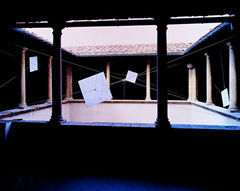 |
Already
in the early Sixties Giulio Paolini was exploring the possibilities of making
art as well as the possibilities offered by the conditions prior to the
artwork’s creation; he investigated that scene which sets the stage
even if it is destined to remain in a suspended state of waiting: the play
never really takes place. The spectator plays an integral part in this staging:
he is both a witness to this preparatory phase and a mirror image of the
maker. All this at a time when deciding to make an artwork might have seemed
like an out-of-date act.
Paolini chose the Pinacoteca in Volterra as the site for his installation.
This museum houses masterpieces from Medieval to Mannerist times, most remarkably
an altarpiece by Rosso Fiorentino in which Christ’s flesh is as green
as if it were painted by Surrealist and the volume of the figures is so
geometric as to foretell Cubism several centuries ahead of time.
All this makes the Pinacoteca a place particularly well suited to Paolini’s
declaration of the impotency to go beyond. The artist denounces his own
state of aphasia by exhibiting symbolic blank pages made of alabaster slabs.
This material (typically found in Volterra and thus an homage to local traditions)
is easily penetrated by light and is therefore permeable, available, waiting
to welcome signs just like a poet’s blank pages or a painter’s
empty canvas. A square slab hovers at the center of the Pinacoteca courtyard,
swaying on its median point, as if it were about to come down or to rise
up on its base, also in alabaster. The empty base - a pure, white parallelepiped
- alludes to the art of sculpture. It seems to be waiting for an object
that will be placed on it or perhaps it is bereft of the sculpture it once
upheld . .
On the third floor of the cloister, the steel cables holding the slabs draw
four vertical planes while the cables that meet at the center draw a plane
that is horizontal and orthogonal with respect to the other four. At the
intersection point of these cables, at the centre of the cloister, a handful
of colored pencils are caught and suspended, as if they were arrows ready
to strike the blank pages but not yet released.
This is a further confirmation of how the alabaster base and five "pages"
form a void: the work is not yet complete or perhaps it can no longer be
completed, hence its title Quasi (Almost). Yet, at the same time, the alabaster
slabs and base, the pencils, the three-dimensional tracing of space produced
by the cables all constitute a presence, a point of departure, a sign of
faith. In other words this is a work that is highly paradoxical because
it addresses the impossibility of making artwork. The installation consists
precisely of this, in designing the present and future on the (even physical
base of the) past, commenting on it and launching it ahead: further proof
that the individual artist - but also Man in general - doesn’t know
how to turn his back on art’s language, nor is he able to; rather than
consider it something closed to him, he continues to explore its skeleton
or, better, its structure. |
|

